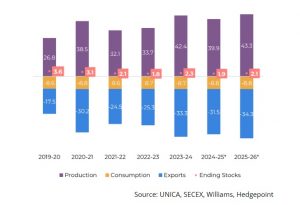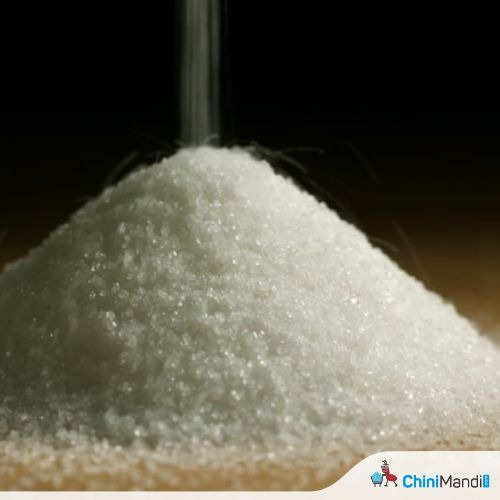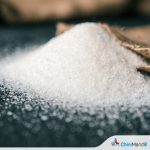January data for NDVI (Normalized Difference Vegetation Index), rainfall, temperature and soil moisture indicate a recovery in the 25/26 crop in the Brazil’s Center-South. Soil moisture improved in the last months of 2024 compared to 2023, and above-average rainfall in the main producing regions, such as Ribeirão Preto, Triângulo Mineiro, Araçatuba and others, favored the development of sugarcane, reflected in a healthier NDVI. In addition, temperatures in the off-season were 1.5 ºC lower than the previous year, suggesting a potential recovery in TCH.
According to Lívea Coda, Market Intelligence Coordinator at Hedgepoint Global Markets, despite the recovery, the poor condition of sugarcane in 2024 may limit the increase, making it difficult to return to 23/24 levels. The expectation is 82 t/ha, with production of 630 Mt, higher than the 617.7 Mt forecast for 24/25.
“The area planted may be lower due to fires and poor conditions, with Hedgepoint’s current estimate of a 2% reduction in 25/26. However, reports of late planting in November could affect the forecast, so this is a factor to watch,” the analyst points out.
Center-South: higher sugar availability for 25/26
The Center-South region should have higher sugar availability next season due to the increase in raw material and the larger sugar mix.
Centre South Supply and Demand Balance (Mt)

“The high premium for sugar over ethanol, combined with increased corn ethanol production and a comfortable feedstock supply, ensures adequate biofuel stocks even with 2% demand growth and the 30% anhydrous blend in gasoline starting in June. With this in mind, mills should continue to prioritize sugar production to maximize revenues,” analyst notes.
Investments in crystallization capacity are expected to be fully operational between 2023 and 2024, enabling 51% sugar production in 25/26. The main risk to this expectation would be a new low quality crop with a higher concentration of reducing sugars.
However, weather conditions have improved and quality problems are usually associated with short-term events, such as the 2024 drought. It will be important to monitor whether there are any anomalies that could affect the sugar mix.
Climate impact on production in 2025
Weather forecasts indicate that 2025 will be a neutral year, with no strong El Niño or La Niña expected, which should bring a climate closer to normal and support a healthy crop.
However, some mills may choose to start crushing a little later as no surplus cane (re-harvested cane) is expected. This would allow more cane development before crushing begins.
“Exports may pick up later, possibly by the end of May, due to the later start of crushing compared to 24/25, when there was surplus cane. This delay may keep trade flows high until the Brazilian harvest picks up. Once crushing starts, prices are expected to adjust due to the expected oversupply,” analyst says.
India: Looking for higher prices
During the Brazilian off-season, availability is tightening and this, combined with India’s search for higher prices to export the 1 million tonnes allowed by the government, has driven up prices. Indian domestic prices rose 4% in January as stocks were depleted.
Meanwhile, raw sugar prices fell 2%, pushing export parity higher. For Indian millers, the ideal parity would be 19.7c/lb for raw sugar, while higher premiums are needed for white sugar even at open parity.
“If India does not export its 1Mt quota, we will see tighter availability in Q2 2025, with prices potentially maintaining a floor of 19+ c/lb. If demand waits for Brazil, prices could stabilize until the correction,” analyst concludes.












